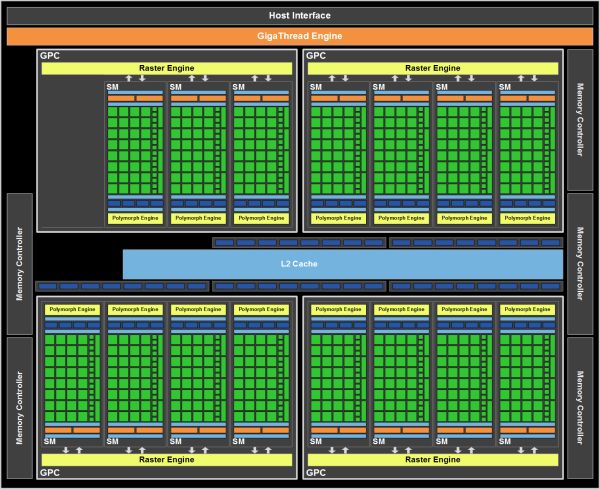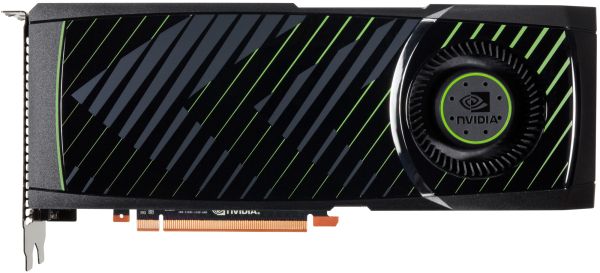NVIDIA's GeForce GTX 570: Filling In The Gaps
by Ryan Smith on December 7, 2010 9:00 AM ESTNVIDIA can be a very predictable company at times. It’s almost unheard of for them to release only a single product based on a high-end GPU, so when they released the excellent GeForce GTX 580 last month we knew it was only a matter of time until additional GTX 500 series cards would join their product lineup.
Now less than a month after the launch of the GTX 580 that time has come. Today NVIDIA is launching the GeForce GTX 570, the second card to utilize their new GF110 GPU. As the spiritual successor to the GTX 470 and very much the literal successor to the GTX 480, the GTX 570 brings the GTX 580’s improvements to a lower priced, lower performing card. Furthermore at $350 it serves to fill in the sizable gap between NVIDIA’s existing GTX 580 and GTX 470 cards.
So how does NVIDIA’s latest and second greatest stack up, and is it a worthy sibling to the GTX 580? Let’s find out.
| GTX 580 | GTX 570 | GTX 480 | GTX 470 | |
| Stream Processors | 512 | 480 | 480 | 448 |
| Texture Address / Filtering | 64/64 | 60/60 | 60/60 | 56/56 |
| ROPs | 48 | 40 | 48 | 40 |
| Core Clock | 772MHz | 732MHz | 700MHz | 607MHz |
| Shader Clock | 1544MHz | 1464MHz | 1401MHz | 1215MHz |
| Memory Clock | 1002MHz (4008MHz data rate) GDDR5 | 950MHz (3800MHz data rate) GDDR5 | 924MHz (3696MHz data rate) GDDR5 | 837MHz (3348MHz data rate) GDDR5 |
| Memory Bus Width | 384-bit | 320-bit | 384-bit | 320-bit |
| Frame Buffer | 1.5GB | 1.25GB | 1.5GB | 1.25GB |
| FP64 | 1/8 FP32 | 1/8 FP32 | 1/8 FP32 | 1/8 FP32 |
| Transistor Count | 3B | 3B | 3B | 3B |
| Manufacturing Process | TSMC 40nm | TSMC 40nm | TSMC 40nm | TSMC 40nm |
| Price Point | $499 | $349 | ~$400 | ~$240 |
The GTX 570 is likely the closest thing we’ll see to a GF110 version of GTX 480 – or any other GF100 card for that matter. With the higher yields afforded by the GF110 design and TSMC’s process improvements, we’ve already seen NVIDIA go for a fully operational GF110 design in the GTX 580, so the GTX 570 works from there. The end result is a melding of the GTX 480’s shader count with the GTX 470’s ROP count and memory bus, and with a clockspeed a bit over GTX 480 and well over GTX 470, performance is much closer to the GTX 480 than the GTX 470.
With 15 of 16 SMs enabled, the GTX 570 matches the GTX 480 at a total of 480 active CUDA Cores and 60 texture units. The core clock is 732MHz, 32MHz (4.5%) over the GTX 480 in order to make up for the reduced ROP/memory blocks and to take advantage of GF110’s lower leakage at higher clocks (as a minor aside, why the strange clocks lately? Look to the PLL). Meanwhile the memory system uses the same 320bit (64bit x 5) memory bus & 10 memory chip configuration we saw on the GTX 470, however this time the memory clock is up to 950MHz (3.8GHz data rate), 113MHz (13.5%) over the GTX 470. Memory clocks are also marginally faster than the GTX 480 by 26MHz, but this isn’t nearly enough to make up for the narrower memory bus. Finally we have the ROPs, which share an existence with both the core and memory subsystems and split the difference – it’s the same 60 ROPs and 640KB of L2 cache as the GTX 470, but because the ROPs run on the core clock they’re running 125MHz (20.5%) faster than the GTX 470.
Since it’s based on GF110, GTX 570 also shares the same architectural enhancements we first saw in the GTX 580. This means GTX 570 can retire twice as many FP16 texels per clock as GTX 480, and it also features NVIDIA’s improved Z-culling system. For the GTX 570 this helps to further close the potential performance gap between the GTX 570 and GTX 480 that results from the lower ROP count and narrower memory bus. Do note however that compared to the GTX 470 the overall improvements are asymmetric: we’re looking at around a 30% theoretical improvement in shading/compute/texture performance, but only a 13.5% improvement in memory bandwidth, so unlike the GTX 580 and its balanced approach, the difference on the GTX 570 is going to be greater on shader-bound games and applications, and lesser when we’re memory bandwidth limited.
As the GTX 470’s successor, the GTX 570 generally fits in the same power and noise profile as the GTX 470. NVIDIA puts the TDP at 219W – a mere 4W over GTX 470 – highlighting the fact that NVIDIA has gone for maximizing performance within their selected power profile for the GTX 570, versus increasing performance but also decreasing power consumption to the GTX 580. The card is otherwise identical to the GTX 580 – the GTX 570 uses the same PCB, the same vapor chamber cooler, and the same shroud as the GTX 580.
NVIDIA is putting the MSRP for the card at $349, a price that in recent weeks has been vacant as neither NVIDIA or AMD had a product to put between the 480/470 and 5970/5870 respectively. Coming from the top-end of the market this is more or less a nice price drop for GTX 480-like performance, but it also means the Radeon 5870 and GTX 470 are the GTX 570’s value threats – the 570’s a good bit faster, but they’re nearly $100 cheaper. The only other competition for the GTX 570 for now will be the GTX 460 1GB SLI and the Radeon HD 6850 CF.
Today’s launch should be a hard launch. Going in to the GTX 580 launch we had our doubts that NVIDIA could have so many GF110 products ready on such short notice, but they were able to prove us wrong there and we’re willing to take them at face value on this. Based on their own estimates and the lower price of the GTX 570 we’d expect some cards to sell out, but availability shouldn’t be an issue.
Finally, with the launch of the GTX 570, NVIDIA’s lineup will be shifting. GF110 is a very effective replacement for GF100 and NVIDIA will be looking to phase out GF100 cards as quickly as they reasonably can. The GTX 470 will still be around for quite some time (all indications are that NVIDIA still has a lot of GF100 chips left) but GTX 480’s days are numbered.
| Winter 2010 Video Card MSRPs | ||
| NVIDIA | Price | AMD |
| $500 | ||
| $470 | Radeon HD 5970 | |
| $410 | ||
| $350 | ||
|
|
$250 | Radeon HD 5870 |
| $240 | Radeon HD 6870 | |
| $180-$190 | Radeon HD 6850 | |












54 Comments
View All Comments
ilkhan - Tuesday, December 7, 2010 - link
I love my HDMI connection. It falls out of my monitor about once a month and I have to flip the screen around to plug it back in. Thanks TV industry!Mr Perfect - Tuesday, December 7, 2010 - link
It is somewhat disappointing. People with existing screens probably don't care, and the cheap TN screens still pimp the DVI interface, but all of the high end IPS panel displays include either HDMI, DP or both. Why wouldn't a high end video card have the matching outputs?EnzoFX - Tuesday, December 7, 2010 - link
High-End gaming card is probably for serious gamers, which should probably go with TN as they are the best against input lag =P.Mr Perfect - Tuesday, December 7, 2010 - link
Input lag depends on the screen's controller, you're thinking pixel response time. Yes, TN is certainly faster then IPS for that. I still wouldn't get a TN though, the IPS isn't far enough behind in response time to negate the picture quality improvement.MrSpadge - Tuesday, December 7, 2010 - link
Agreed. The pixel response time of my eIPS is certainly good enough to be of absolutely no factor. The image quality, on the other hand, is worth every cent.MrS
DanNeely - Tuesday, December 7, 2010 - link
Due to the rarity of HDMI 1.4 devices (needed to go above 1920x1200) replacing a DVI port with an HDMI port would result in a loss of capability. This is aggravated by the fact that due to their stickerprice 30" monitors have a much longer lifetime than 1080p displays and owners who would get even more outraged as being told they had to replace their screens to use a new GPU. MiniDVI isn't an option either because it's singlelink and has the same 1920x1200 cap as HDMI 1.3.Unfortunately there isn't room for anything except a single miniHDMI/miniDP port to the side of 2 DVI's, installing it on the top half of a double height card like ATI has done cuts into the cards exhaust airflow and hurts cooling. With the 5xx series still limited to 2 outputs that's not a good tradeoff, and HDMI is much more ubiquitous.
The fiasco with DP-DVI adapters and the 5xxx series cards doesn't exactly make them an appealing option either to consumers.
Mr Perfect - Wednesday, December 8, 2010 - link
That makes good sense too, you certainty wouldn't want to drop an existing port to add DP. I guess it really comes down to that cooling vs port selection problem.I wonder why ATI stacked the DVI ports? Those are the largest ports out of the three and so block the most ventilation. If you could stack a mini-DP over the mini HDMI, it would be a pretty small penalty. It might even be possible to mount the mini ports on edge instead of horizontally to keep them all on one slot.
BathroomFeeling - Tuesday, December 7, 2010 - link
"...Whereas the GTX 580 took a two-tiered approach on raising the bar on GPU performance while simultaneously reducing power consumption, the GeForce GTX 470 takes a much more single-tracked approach. It is for all intents and purposes the new GTX 480, offering gaming performance..."Lonyo - Tuesday, December 7, 2010 - link
Any comments on how many will be available? In the UK sites are expecting cards on the 9th~11th December, so not a hard launch there.Newegg seems to only have limited stock.
Not to mention an almost complete lack of UK availability of GTX580s, and minimal models and quantities on offer from US sites (Newegg).
Kef71 - Tuesday, December 7, 2010 - link
Or maybe they are a nvidia "feature" only?